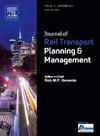Optimizing and synchronizing timetables in an urban subway network considering trains’ speed profiles and skip-stop strategy
IF 2.7
Q3 TRANSPORTATION
Journal of Rail Transport Planning & Management
Pub Date : 2025-05-05
DOI:10.1016/j.jrtpm.2025.100520
引用次数: 0
Abstract
This research aims to introduce a mathematical model capable of producing an optimal and coordinated timetable for the entire urban rail network to minimize passengers’ travel times and the trains’ energy consumption. The proposed model focuses on different speed profiles and a skip-stop strategy while considering the stochastic nature of passengers’ arrival and departure rates. This novel model can generate an optimal real-time schedule under variations in passenger demand. The implementation of a multi-agent deep deterministic policy gradient has been described, and it has been compared with a genetic algorithm. Eventually, this methodology is implemented on lines 1, 2, and 4 of Tehran’s metro network as a case study. The results indicate that using the skip-stop strategy and optimizing trains’ speed profiles along their paths can reduce the networks’ costs, including passengers’ waiting costs and the trains’ energy consumption costs, by 2.9% and 14.9%, respectively.
考虑列车速度分布和跳站策略的城市地铁网络时刻表优化与同步
本研究旨在引入一种数学模型,能够为整个城市轨道网络产生最佳和协调的时间表,以最大限度地减少乘客的旅行时间和列车的能源消耗。该模型在考虑乘客到达率和离开率的随机特性的同时,重点考虑了不同的速度分布和跳停策略。该模型可以在乘客需求变化的情况下生成最优的实时时刻表。描述了一种多智能体深度确定性策略梯度的实现,并将其与遗传算法进行了比较。最后,将该方法应用于德黑兰地铁网络的1、2、4号线作为案例研究。结果表明,采用跳站策略和优化列车运行路径的速度分布,可使网络成本(包括乘客等待成本和列车能耗成本)分别降低2.9%和14.9%。
本文章由计算机程序翻译,如有差异,请以英文原文为准。
求助全文
约1分钟内获得全文
求助全文
来源期刊

Journal of Rail Transport Planning & Management
TRANSPORTATION-
CiteScore
7.10
自引率
8.10%
发文量
41
 求助内容:
求助内容: 应助结果提醒方式:
应助结果提醒方式:


